
Source image: id.wikipedia.org
Explanation of traditional musical instruments Angklung derived from the Sundanese community of West Java. Angklung is a musical instrument multitonal (pitched double) made of bamboo. How to play it quite easily just by shaking it. The resulting sound is caused by a bamboo pipe body clash. The resulting sounds vibrate in a tone of 2, 3, to 4 tones in each size, both large and small.
Jonathan Rigg's Dictionary of the Sunda Language, published in 1862 in Batavia, writes that angklung is a musical instrument made of bamboo pipes, cut into the edges, resembling pipes in an organ, and tied together in a Frame, vibrated to produce sound. Angklung is listed as Masterpiece of Oral and Non-Angelic Cultural Heritage of UNESCO since November 2010.
#ingredients
Bamboo which is used as angklung material is black bamboo (awi wulung) and white bamboo (awi temen). Each tone produced comes from the bamboo tube-shaped bamboo blade of each bamboo segment from small to large.
#function
The period of the Sunda kingdom, Angklung used among them as an encouragement in the battle. Angklung function as a pumping spirit of the people still continues to feel until the colonial period, that's why the Dutch East Indies government had banned the community using angklung, the ban had made the popularity of angklung decline and only played by children at that time.
#Type angklung
- Angklung Kanekes
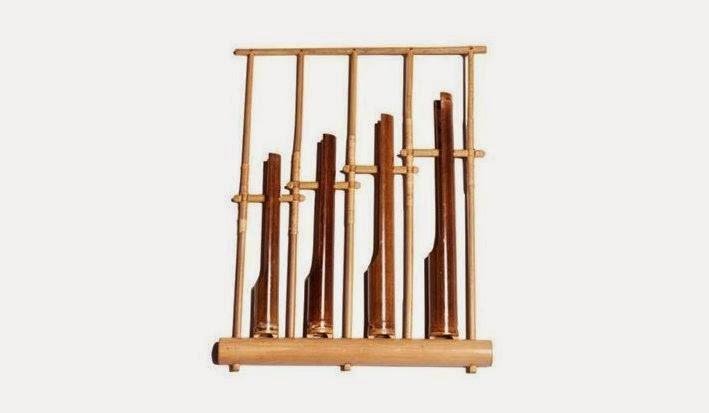
Source image: VIVA.co.id
Angklung in the Kanekes region (we often call them Baduy people) is used primarily because of its association with rice rites, not solely for the entertainment of the people. Angklung used or sounded when they planted rice in the fields.
2.Angklung Reyog
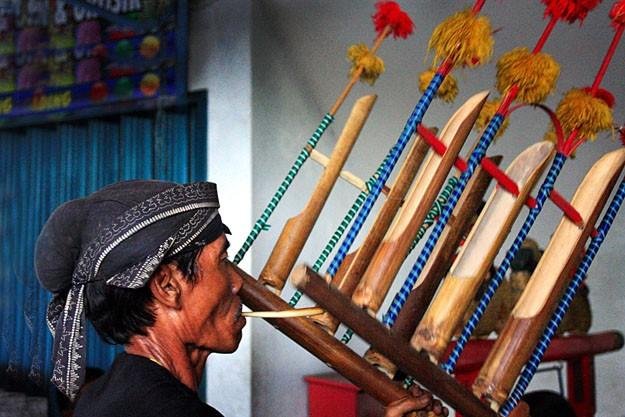
Source image:khazanahindonesia.lpsn.org
Angklung Reyog is a musical instrument to accompany the reyog ponorogo dance in eastern Java. Reyog angklung has a distinctive in terms of a very loud sound, has two tones and the shape of the rattan arch is interesting and its shape is not like angklung generally shaped cube. This angklung has a beautiful fringed tassel of yarn.
3.Angklung Banyuwangi

Source image:lurulagu.com
Angklung is shaped like a calung with a banyuwangi culture tone
4.Angklung bali

Source image:pascabahasa.blogspot.com
Angklung bali has typical Balinese shapes and tones.
5.Angklung dogdog Lojor
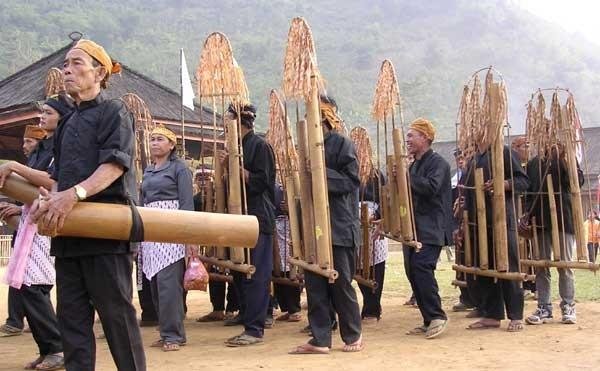
Source image:kotamanusia.worldpress.com
The art of dogdog lojor is found in the Kasepuhan Pancer Pangawinan community or Banten Kidul customary unity spread around Halimun Mountain. Although this art is called dogdog lojor, which is the name of one of the instruments in it, but there is also used angklung because of its relation to the rice ritual event.
6.Angklung gubrag

Source image:indonesiakaya.com
Angklung gubrag is located in Cipining village, Cigudeg sub-district, Bogor. Angklung is old and used to honor the rice goddess in the activities of growing rice, transporting rice, and putting into the barn.
7.Angklung badeng
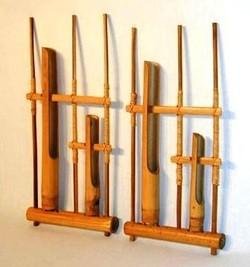
Source image:andriasmulyadi.weebly.com
Milkfish is a type of art that emphasizes the musical aspect with angklung as its main musical instrument. Badeng is in Sanding Village, Malangbong Sub-district, Garut.
8.Angklung padaeng

Source image:klungbot.com
Angklung keeng is angklung introduced by Daeng Soetigna since about 1938. The breakthrough in angklung keeng is the use of Diatonic tone barrel which is in accordance with western music system. Thus, angklung can now play international songs, and can also play in Ensembel with other international musical instruments.
9.Angklung sarinande
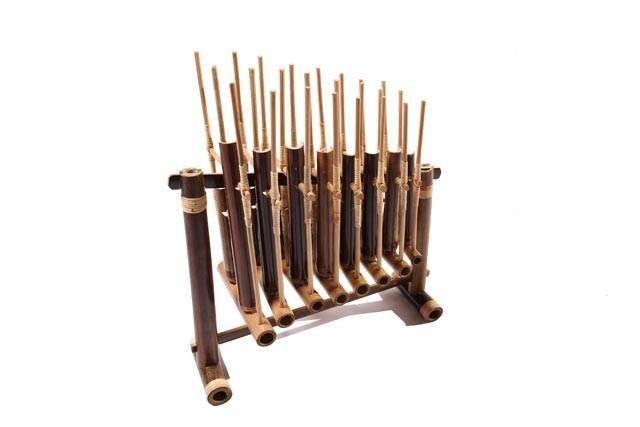
Source image:artmediashop.en.ecplazza.net
Angklung sarinande is a term for angklung keeng which only uses round tones alone (without chromatic tones) with basic tone C. Small unit of angklung sarinade contains 8 angklung (Do not Do to Low tones), while sarinade plus contains 13 angklung (Low Sol tones Mi High).
10.Angklung toel

Source image:youtube.com
Angklung toel was created by Kang Yayan Udjo around 2008. In this tool, there is a waist-high frame with some angklung lined up with the position upside down and given rubber. To play it, a player just toel the angklung, and angklung will vibrate for a while because of the rubber.
11.Angklung sri murni

Source image:khoerrfiqriyah.blogspot.com
Angklung is the idea of Eko Mursito Budi specially created for the purposes of angklung robot. As the name implies, one angklung uses two or more voice tubes of the same tone, which will produce a pure (mono-tonal) tone. This is different from angklung padaeng multi-tonal. With this simple idea, robots easily play a combination of several angklung simultaneously to simulate the effects of angklung melodies and angklung akompanimen.
12.Angklung solo

Source image:buluhvoice.blogspot.com
Angklung solo adalah konfigurasi dimana satu unit angklung melodi digantung pada suatu palang sehingga bisa dimainkan satu orang saja. Sesuai dengan konvensi nada diatonis, maka ada dua jajaran gantungan angklung, yang bawah berisi nada penuh, sedangkan yang atas berisi nada kromatis. Angklung Solo ini digagas oleh Yoes Roesadi tahun 1964, dan dimainkan bersama alat musik basanova dalam group yang menamakan diri Aruba (Alunan Rumpun Bambu). Sekitar tahun 1969, nama Aruba ini disesuaikan menjadi Arumba.
#Angklung game technique

Source image:indonesiakreatif
How to play angklung quite easy to live because it holds the chassis in one hand (usually the left hand) so that angklung hanging free, while the other hand (usually the right hand) to shake it to sound. In this case, there are three basic techniques to shake the angklung:
Curl, is the most commonly used technique, where the right hand holds the base tube and vibrates left and right many times as long as the tone is about to be played.
Centok (jerk), is a technique where the base tube is pulled quickly by the finger to the right hand palm, so the angklung will sound just once (stacato).
Tengkep, like the eldest but one of the tubes on hold does not come vibrate. In angklung melody, this technique causes angklung to release a pure tone (one melodic tone only, not two as usual). Meanwhile, in the major akompanimen angklung, this technique is used to play the major chord (3 tones), because if not plastered the playable is the dominant chord septim (4 tones).
Meanwhile, to play one unit angklung to bring a song, will be required many musicians led by a conductor. On each musician will be distributed one to four angklung with different tones.
That is a brief explanation of traditional angklung musical instruments from West Java. For more details please visit Wikipedia Indonesia.
Angklung looks the same but the name is different because different regional areas also his name .. ORIGINAL INDONESIA
Source story: Zulfa Azizah
Thank you for your support I hope the original work of Indonesia can survive and have global. Hopefully we can be good friends ya @yooraa for his WA number ya let me share the experience
post a great can be useful can be used as experience .semoga be a friend who can help me in order to like you ..... to dream and hope in reach. like @yooraa need dukugan friend. greetings esteem.